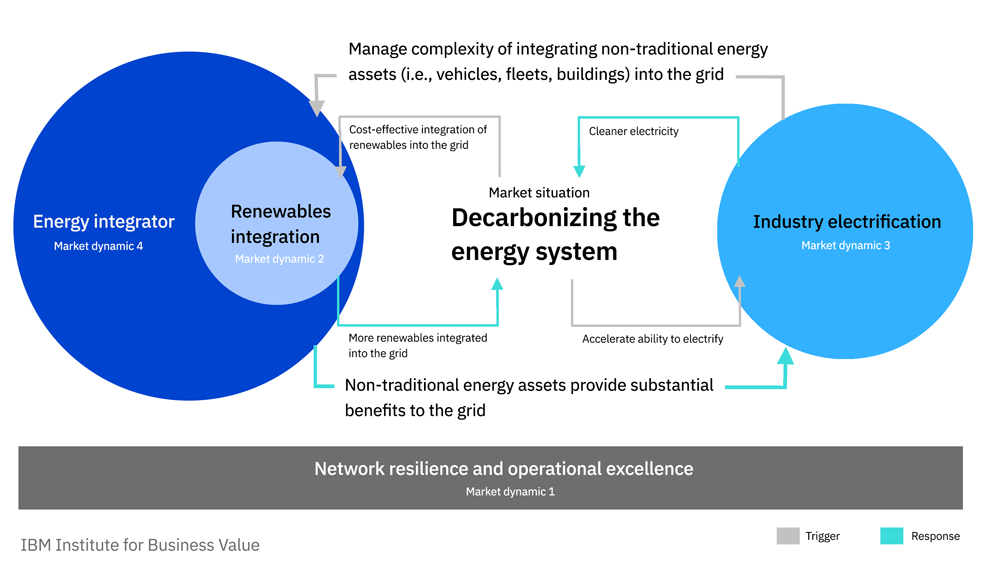Across the world, electricity systems are decarbonizing. The reasons are varied, but certainly there’s a deep understanding by society and governments that transforming the electricity infrastructure is critical. Our industry is responsible for about one-third of global manmade carbon emissions, yet, it’s one of the easier sectors to rapidly decarbonize. This is due to the relative density of carbon sources in this sector, such as coal- and natural gas-fueled power plants, along with the historical social contract and attendant regulatory oversight of this industry.
It’s already happening:
- US coal power-generation plummeted 30 percent during the first six months of 2020, driven by COVID-19 and depressed prices.
- Retailer Target announced their intent to be 100 percent powered by renewables by 2030; Apple’s operations are already there, and they’ve announced every Apple device will have zero climate-impact by 2030.
- Amazon has doubled-down, indicating they’ll invest USD 2 billion in clean energy venture capital.
- Commercial real estate markets including Chicago, San Francisco, and Atlanta are increasing their rentable square footage in green energy buildings, and have crossed the 50 percent threshold.
- A 12 megawatt energy storage project in the Netherlands has successfully raised EUR 3.6 million (USD 4.03 million) through crowdfunding, offering a 5 percent interest to investors, who chipped in a minimum of EUR 500 each.
Consumers are demanding change, and they’re holding governments and companies accountable.
Government policies such as renewable energy portfolio standards (RPSs) and tax credits kickstarted the move to renewables. This has enabled non-carbon emitting power generation sources (particularly wind and solar) to reach price parity with traditional generation technologies, and their price curves continue to drop.
Battery storage is on a price/performance curve similar to solar generation and remains the missing piece that will allow renewables to provide services equivalent to those available from controllable fossil-fueled generation.
These facts underpin our vision, Electrifying Energy (EE): Sustainably fueling the future.
EE is the global movement that supports decarbonization of large portions of the economy through clean electrification, while maintaining and increasing the reliability and resilience of the electric grid by (1) assuring that the electric grid is reliable and resilient; (2) providing an ever cleaner electric grid; and (3) extending clean reliable electricity to the broader economy.
EE addresses the urgent market and societal need for decarbonization
Societies expect electric utilities to provide uninterrupted power to connected customers in a safe, affordable manner. Electricity is essential; it’s the “infrastructure of infrastructures” (meaning without electricity there’s no water, gas, or communications). Electricity is so important that it’s often government-owned or at least heavily regulated.
The fundamental change is around the energy transition: substantial substitution of clean electricity for fossil fuels in other sectors of the economy. This replacement must be done while delivering a safe, reliable, affordable, and continuous service.
Our work with the IBM Institute for Business Value (IBV) on the recent report, “Digitizing Electric Utilities: Core Performers power up reliability and resiliency,” speaks directly to the importance of improving and automating infrastructure to prepare for today, as well as tomorrow. Making changes that drive reliable and efficient systems improves the odds of successful outcomes.
The factors and market dynamics propelling enhanced electric infrastructures include:
Decarbonizing the energy system: Electric utilities’ decarbonization is primarily driven by three factors—societal, political, regulatory, in addition to economic factors:
- renewable energy generation has reached price-parity with fossil fuel generation and continues to decrease
- renewables remove commodity (fuel) risk from energy company’s portfolios
- as a result, financiers of new power generation are investing the majority of their funds in renewable energy projects, instead of traditional fossil-fueled projects
The four market dynamics of Electrifying Energy

Network resilience and operational excellence: Utilities must do what they’ve always done: maintain the social contract of providing uninterrupted power to connected customers in a safe and affordable manner. Utilities must adapt to current climate-related risks while mitigating for future ones. The sophistication required to maintain this contract increases as the economy becomes more dependent on electricity for core energy needs. This results in an electricity system that becomes more complex, diversified, and resilient.
Renewables integration: Utilities must integrate intermittent, uncontrollable wind and solar power into the existing grid infrastructure, which depends on large, central power plants feeding energy one-way to customers, through the electricity grid. Most of this new renewable energy comes from large-scale wind farms or solar farms, connected to the grid’s high voltage system (the transmission system).
Industry electrification: Business and government leaders are replacing fossil fuel with electricity as their primary energy source, due to a lower cost of energy, primarily from renewables and increased cost certainty, compared to volatile commodities like natural gas, and lower carbon content.
Some industries are becoming “fuel switch” early adopters, particularly transportation and the residential and commercial building sectors. In 2018, buildings consumed about 29 percent of global energy, while transport consumed 21 percent. Manufacturing and industrial processes are also electrifying to some degree, and electrification in these areas can make sizable differences.
Utilities must provide exceptional resilience, reliability, and access that offsets fossil fuel’s advantages in those areas. Simultaneously, utilities must accelerate the clean electrification of their grids to continuously widen their environmental advantage over the competing energy sources. As more organizations embrace this approach, the greener, more affordable, and resilient the grid becomes. This creates a virtuous cycle, where more electrification, increased resilience, and newly electrifying industries can meet their environmental goals more quickly.
Energy integrators: As the number of non-utility owned and operated resources connected to the grid increases exponentially, a fundamental rethinking of the electrical system's operation is required, as well as the utility's role within it. We term this new role the Energy Integrator, and we’ve anticipated this need for several years.
As the grid transitions to an even more complex network, with energy and grid services going both to and from customers, improved technologies and solutions are needed. This is where IBM is investing to help clients move toward a sustainable, greener energy future. Over the next few months, we’ll be sharing more research and perspective on how to leverage a balanced, risk-mitigated portfolio of existing and emerging solutions. Our vision is: Electrifying Energy: Sustainably fueling the future.
The utility industry is moving toward a fundamental shift in its operations in support of the global Energy Transition. The speed at which this transition occurs depends on many factors, some in the utility industry’s control, and many external.
Certainly, new and maturing information technologies such as AI, blockchain, 5G/edge and cloud will be important enablers for this more collaborative, fast-paced, and networked electricity system. At the same time, continued and growing delivery of clean, reliable, and resilient electricity to extended sectors of the global economy will require a “fast evolution,” —not “revolution” of the industry—leveraging and extending existing solutions to reliably accelerate the energy transition.
Subscribe now for access to data-driven research and expert analysis for utilities leaders about emerging trends and navigating dynamic environments. You can find our perspectives on new and maturing information technologies such as AI, blockchain, 5G/edge, and cloud. These digital technologies will be important enablers in a collaborative, efficient, and networked electricity system. At the same time, we’ll be supporting the growth of clean, reliable, and resilient electricity to extended sectors of the global economy.
Meet the author



